The Old Conduit House and the connection to Stained Glass windows - Part 1
Yesterday Anne gave us the history of The Old Conduit House, a magnificent heritage listed home which she happened to come across out whilst out walking during her recent stay in the UK. (Click here if you missed it.)
As we have previously written about stained glass on the blog, (links in the footnotes below), I was very interested to read that this house was originally built as two residences by the stained glass manufacturers John Burlison and his son-in-law, Alfred Bell - with a connecting door between them!
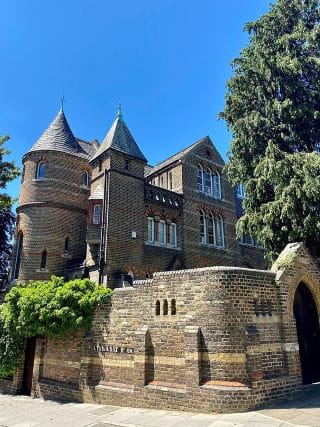
It turns out that the house provides a link to two eminent and prolific firms producing stained glass more than 150 years ago in England.
The first one we will look at is the Alfred Bell connection. Clayton and Bell was one of the most prolific and skilled manufacturers of stained-glass windows in the UK during the latter half of the 19th century and early 20th century.
The firm was established by John Richard Clayton (1827–1913) and Alfred Bell (1832–1895) in 1855. It continued production until 1993, for almost 140 years. Their windows are found throughout the United Kingdom, in the United States, Canada, Australia and New Zealand, to name a few. 1
During the Medieval period, from the Norman Conquest of England in 1066 until the 1530s, stained glass was produced and installed in churches, monasteries and cathedrals all over Britain. However, much of it was destroyed under Henry VIII as part of The Reformation in the late 1530s and later again by Oliver Cromwell in the 17th century. Henry wanted to break away from the Catholic rules of not allowing divorce and established his own Church of England. His rampaging destruction, called The Dissolution of the Monastries, also had the added benefit (for Henry) of transferring much land and wealth to the Crown, as up to 25% of English land at the time was owned by religious entities.
However, there was a renewal of Roman Catholicism in the early 19th century in which many new churches were established (particularly in areas of the new industrial growth), as well as the restoration of many of the destroyed ancient abbeys and cathedrals back to their Medieval glory.
In the 1850s a number of young designers were working in conjunction with various Gothic Revival architects to provide stained glass for these new and restored churches. These designers included John Richard Clayton and Alfred Bell.
From a young age, Alfred Bell had shown a real aptitude for art and had been recommended as a student to the renowned architect Sir George Gilbert Scott (1811 - 1878) when he was about 14 years of age. (Scott was responsible for the restoration of many of England's finest Medieval structures including Salisbury, Worcester, Chester, Ely and Durham Cathedrals). Scott noted that Alfred's productions at that early age were most remarkable, and, "....during the whole time that he was with me, nothing he had to do seemed to present any difficulty whatsoever to him." In 1848, Scott offered the 16 year old Alfred a pupilage at his offices in London2 and off he went.
John Richard Clayton was also a pupil of George Scott, which is how they met and their professional paths aligned. They decided to form their own company, Clayton and Bell, after learning their craft.
Initially Clayton and Bell's designs were manufactured by Heaton and Butler, with whom they shared a studio between 1859 and 1862, employing the very talented Robert Bayne as a designer as well.
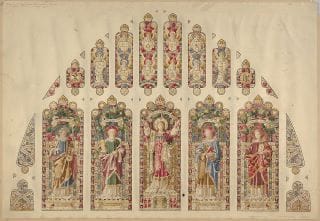
Clayton and Bell, along with other designers, were in the right place at the right time to ride the wave of huge demand.
In 1861 they were successful enough to start manufacturing their own glass. Robert Bayne became part of the partnership with Heaton and Butler, forming the firm Heaton, Butler and Bayne. Nathaniel Lavers, who had worked with Bell, also formed a separate partnership as Lavers, Barraud and Westlake in 1862.1 There were many others, and there was plenty of work for them all!
There was a good deal of interaction and influence between Clayton and Bell, and Heaton, Butler and Bayne. The windows of both firms share several distinguishing features and characteristic colour-combinations which are uncommon in other designers.
Clayton and Bell moved into large premises in Regent Street, London, where they employed about 300 people. In the late 1860s and 1870s the firm was at its busiest, and employees worked night shifts in order to fulfil their commissions. Wow! Can you believe it!
In summary, Clayton and Bell's commercial success was due to the high demand for stained-glass windows at the time, their use of the best-quality glass available, the excellence of their designs and their employment of efficient factory methods of production. 1
Here are some more examples of their work:
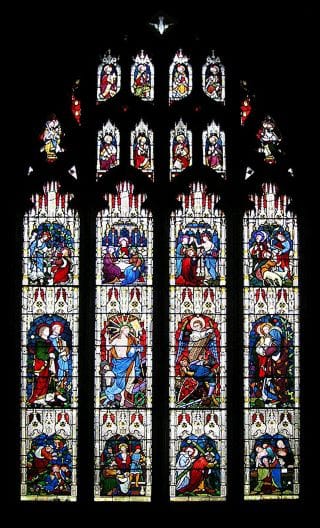
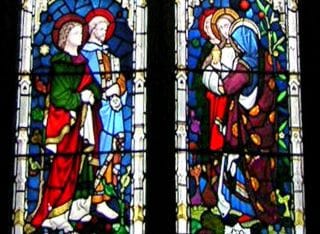
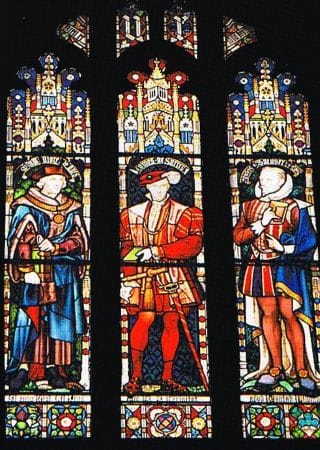
Examples of stained class windows by Clayton and Bell. Credit: Public Domain
The 19th-century windows of Clayton and Bell are typified by their brilliant luminosity. This is because they were quick to adopt the advice of the student of Medieval glass Charles Winston, who propounded that "modern" commercially made coloured glass was not effective for stained-glass windows, as it lacked the right refractive quality. In 1863 John Richard Clayton was among those who was experimenting with the manufacture of so-called pot metal or coloured glass produced by simple ancient manufacturing techniques which brought about great variability in the texture and colour of glass which is characteristic of the ancient windows.1
Despite many of the records of the firm being lost in the bombing of World War II, the following book mark link contains more detail about the commissions of Clayton Bell, as well as a list of places around the world where their work can be seen today. Maybe there are some near you!
After the deaths of Alfred Bell in 1895 and John Richard Clayton in 1913, the firm continued under Bell's son, John Clement Bell (1860–1944), then under Reginald Otto Bell (1884–1950) and lastly Michael Farrar-Bell (1911–1993) until his death.
So now we know a little about Alfred Bell, one of the builders of The Old Conduit House. But who was John Burlison, the other owner of the house, and how did he and Alfred Bell become related?
We will return tomorrow to find out the connection.....
Footnotes
- With thanks to Wikipedia
- With thanks to Wikitree, https://www.wikitree.com/wiki/Bell-30860.
Links to our past posts on stained glass can be found below:

